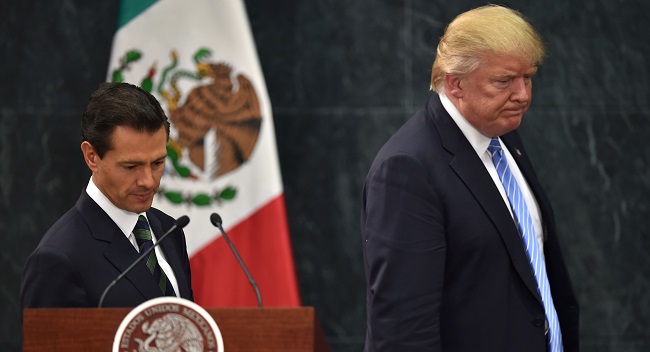
President Donald Trump has made it clear that his presidency will have a position on everything everywhere. He has also made it clear that he alone will make the final decision on the policy his government will follow. He has chosen two priority areas in implementing his policies: Mexico and Syria/Iraq, which is the zone of strength for the caliphate of the Islamic State (IS). We may call these two areas the hotspots, in which Trump is acting in his most provocative fashion.
Mexico was arguably the principal subject of his entire campaign, first for the Republican nomination and then for the presidential election. It is probably the case that his incessant harsh statements about Mexico and Mexicans earned him more popular support than any other subject, and thereby won him the presidency.
Trump correctly sees that if he failed to make action against Mexico a priority, he risked a rapid and serious disillusionment among his most ardent supporters. So he has done just that.
In his very first days in office, he has reiterated that he will build a wall. He has asserted that he is seeking a major revision of NAFTA, failing which he will repudiate the treaty. And he has repeated his intention to make Mexico pay for building the wall by instituting a tax on all Mexican imports into the United States.
Can he actually do all that? There are legal and political problems for him in implementing the program. The legal obstacles under U.S. and international law are probably not that great, though the United States might be charged with violating provisions of the World Trade Organization (WTO). If that were to happen, Trump would probably be ready to withdraw the United States from the WTO.
The political obstacles are more serious, making it less certain that he can carry out his program fully and swiftly. There is serious opposition within the United States to the project, both on moral and pragmatic grounds. The pragmatic objection is that a wall would be ineffective in reducing the entry of undocumented workers and merely increase the cost and danger for individuals to cross the frontier. Interestingly, pragmatic objections are being voiced even by Texas ranchers, who have been among his strongest supporters. And of course there are many U.S. enterprises that are dependent on undocumented workers, and who would be serious losers. They will constitute a pressure force within Congress to weaken such a policy.
Nor is it clear that he can actually pass on the cost of building the wall to Mexican exporters. There are already many analyses that claim that, via the increased cost of Mexican imports into the United States, the cost will eventually be borne by U.S. consumers as well as, or in substitution for, Mexican exporters.
On the Mexican side, President Enrique Peña Nieto initially made an effort to negotiate border issues with President Trump. He sent two ministers to Washington to engage in preliminary discussions. He welcomed Trump in a visit to Mexico and had scheduled a visit to Washington himself. This soft response to Trump’s statements was unpopular in Mexico. And Peña was under attack at home for many other issues as well for some time now.
Trump’s evident disinterest in any accommodation of Peña was the last straw. It was seen in Mexico as humiliating. Peña cancelled his trip and assumed a stance of defying Washington. By doing this, he has managed to get his internal critics to rally round him as a champion of Mexican national pride.
I ask again: Can Trump make Mexico bend to his will? In the very short run, he may be viewed as fulfilling his campaign pledges. In the middle run, however, it is not at all sure that Trump will emerge from this hotspot with a record of achievement.
Syria/Iraq is an even more difficult hotspot. Trump has said that he has a secret plan to eliminate the Islamic State. Typically, he has given the Pentagon thirty days to come up with its proposals. Only then will he announce his decision.
There are already a whole series of problems for Trump. Russia now seems the strongest single political actor in the region. It has taken the road of creating a political peace process that includes Bashar al-Assad’s government, the principal Syrian opposition force, Turkey, and Iran (along with the Hezbollah). The United States, western Europe, and Saudi Arabia are all excluded.
Such exclusion is intolerable for Trump who is now speaking of sending in U.S. ground troops to fight the IS. But with whom will such troops ally themselves in Syria or Iraq? If the Iraqi Shia-dominated government, they will forfeit the support of Iraqi Sunni tribal forces that the United States has been cultivating despite their one-time support for Saddam Hussein. If the Kurdishpeshmerga, they will antagonize further both Turkey and the Iraqi government. If Iranian forces, they will set up howls in the U.S. Congress and in both Israel and Saudi Arabia.
If Trump sends in troops despite this, he will find it almost impossible to extract them, as did George W. Bush and Barack Obama before him. But with the inevitable U.S. casualties, support at home will disappear. He will thus be getting less short-term applause than for Mexico and probably more middle-run frustration. Sooner or later, both he and his supporters will learn the bitter truth of the limits of U.S. geopolitical power, and therefore the limits of Trump’s world power.
What then? Will Trump explode and commit dangerous acts? This is what most of the world fears – a United States that is too weak in real power and too strong in weaponry. Trump will face a choice between two alternatives: using the weapons he has, which is futile but terrible; or a quiet withdrawal from geopolitics into fortress America, an implicit admission of failure. In either case, it will be a very uncomfortable decision for him.
